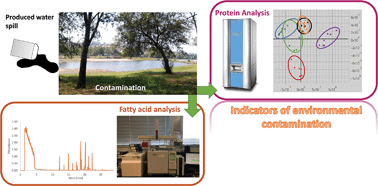Analysis of bacteria stress responses to contaminants derived from shale energy extraction†
Abstract
In order to survive environmental changes, bacteria have stress responses, which protect them from adverse and variable conditions. Contamination can be a source of stress and bacterial responses can serve as an indicator of environmental abnormality. In this work, the biochemical effects of toxic compounds that stem from hydraulic fracturing were measured on the whole cell-derived fatty acid and protein compositions of Escherichia coli, Klebsiella oxytoca, Pseudomonas aeruginosa, Pseudomonas putida, Pseudomonas stutzeri, Aeromonas hydrophila, Bacillus cereus, and Bacillus subtilis. These microorganisms were exposed to elevated levels of benzene, ethanol, propanol, toluene, and salt. These were chosen to represent significant subsurface contamination or a surface spill. The fatty acid and protein profiles for the bacteria were analyzed using gas chromatography – vacuum ultraviolet spectroscopy and matrix-assisted laser desorption ionization time-of-flight mass spectrometry, respectively. Overall, different fatty acid and protein profiles were observed when the microorganisms were grown in the presence of the toxic compounds. The cells exhibited an increase in the saturated/unsaturated ratio and displayed the presence of branched and cyclopropane fatty acids when in the presence of common fracture fluid constituents to decrease membrane permeability which was confirmed by the analysis of produced water. This approach provides a potentially useful tool for environmental diagnosis, since proteins and fatty acids can act as a harbinger of ecological health.

- This article is part of the themed collection: The environmental geochemistry and biology of hydraulic fracturing


 Please wait while we load your content...
Please wait while we load your content...